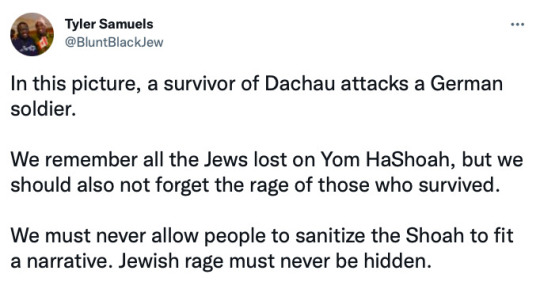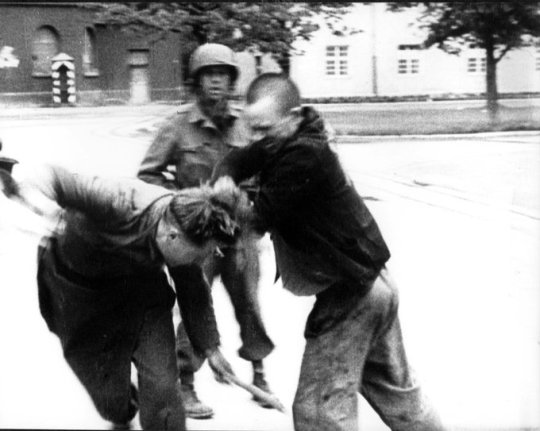#Yom Hashoah
Text
It is Holocaust remembrance day. Let us all remember those who survived the Shoah and those who did not. Let us also remember the many survivors who are no longer with us today.
May their memory be a blessing.
Never again is now.
2K notes
·
View notes
Text
So, I know that quite a few people know the Jewish joke: “they tried to killed us, we survived, let’s eat”, and a friend found this chart years ago explaining all the Jewish holidays and fast days through that joke, with one very important addition: TREES.
And since today was Tu B’Shvat, I found myself thinking that this would be a great day to share it.
Enjoy :)) and hag sameach!! <333
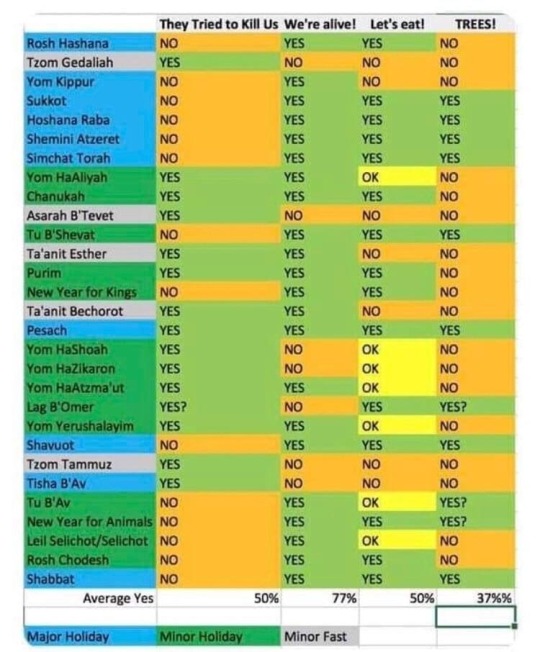
#judaism#jewish#jumblr#jewposting#tu bishvat#shabbat#purim#pesach#shavuot#lag b’omer#shmeni atzeret#hoshana raba#sukkot#simchat torah#yom yerushalayim#yom ha’atzmaut#tzom gedaliah#asara b’tevet#yom hashoah#yom hazikaron#rosh chodesh#yom kippur#rosh hashanah#hannukah#tu b’av#shiva asar b’tammuz#tisha b’av#ta’anit esther#jewish holidays#new years
488 notes
·
View notes
Text
80th Anniversary of the Warsaw Ghetto Uprising: "The World Has to Know That We Did Not Go Like Lambs to the Slaughter."
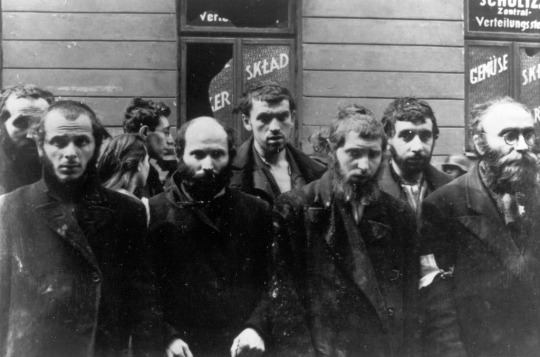


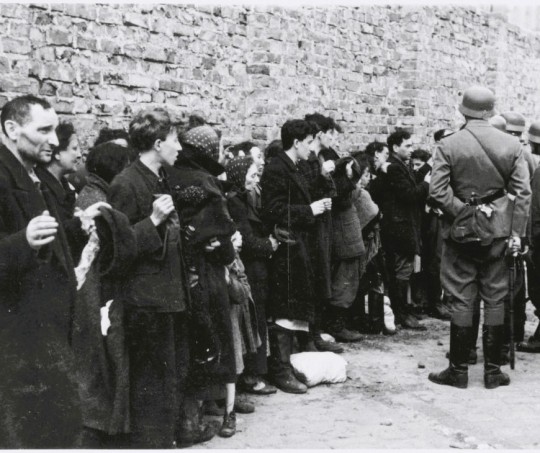
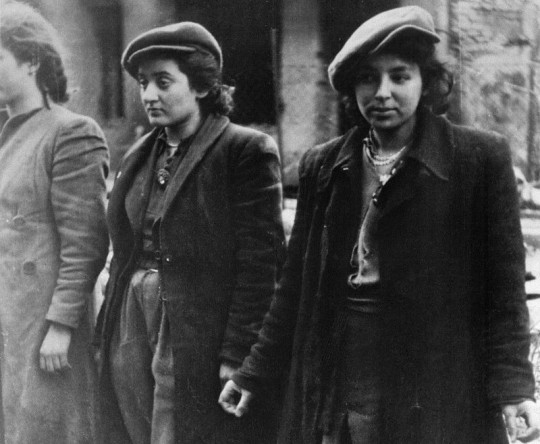
April 19th, 1943 - May 16th, 1943
Warsaw, Poland
“The question is not why all the Jews did not fight, but how so many of them did. Tormented, beaten, starved, where did they find the strength, spiritual and physical, to resist?” – Elie Wiesel
In the morning of April 19th, 1943, on what would be the first night of Passover, the Warsaw Ghetto Uprising began. German troops and SS entered the ghetto to deport its surviving inhabitants to the death camps.
In the summer of 1942, as Jews living in the Warsaw ghetto were deported to Treblinka, reports that made their way back quickly made it clear that "resettlement" meant mass-murder. In response to this, Jews citizens in the ghetto began forming organized resistance forces; the Jewish Combat Organization (ŻOB) and the Jewish Military Union (ŻZW).
Following the January 1943 success of a smaller-scale resistance preventing a deportation attempt, an act that led to the suspension of such deportation efforts by the Nazis, the residents began to secretly build subterranean tunnels and shelters in preparation for a full-scale uprising.
Throughout April rumours swirled of a final deportation of the ghetto's remaining Jews. On the 18th it became clear that German forces, reinforced with artillery and tanks, were moving in to carry out their final action. The alarm was raised, and residents retreated to their underground shelters. They would remain here for the duration of the uprising, refusing to surrender themselves to deportation.
A group of around 700 Jewish resistance fighters, made up of the ŻOB and ŻZW and led by 24-year-old Mordechai Anilevitch, joined together to stage what would be their final stand against the Nazis. These brave young people were malnourished and lacked proper military training, they were equipped with nothing but poor-quality or even homemade weapons and their bare hands.
By contrast German forces numbered 2000, they were well-equipped and well-trained and had advanced knowledge of the existence of these resistance groups.
Despite this stark imbalance, on the first day of the uprising the ragtag Jewish fighters met the invaders head on and successfully forced the Nazis to retreat outside the city walls.
Amongst all of the chaos and destruction all around them, the Jews hiding in the tunnels and bunkers gathered together to celebrate Passover with what little they had, breaking homecooked matzah and drinking illicitly obtained wine.
The Warsaw Ghetto Uprising held strong for a full 27 days, coming to an end on May 16th, 1943. Unable to gain a full advantage, the Germans had resorted to burning the Warsaw Ghetto to the ground in an attempt flush out those in hiding so they could be rounded up.
In the months following the official end of the uprising some Jews remained hiding out in the rubble, periodically attacking German police on patrol.
This was the largest uprising by Jews during World War II and the first significant urban revolt against German occupation in Europe. It inspired many more uprisings, especially amongst Jews in camps and Ghettos.
May Their Memories Be a Revolution
Learn More:
Warsaw Ghetto Uprising | Holocaust Encyclopedia
Holocaust Survivors Describe the Last Passover in the Warsaw Ghetto
Tuesday, Nissan 27, 5783 / April 18, 2023 - Jewish Calendar - On This Day
#jumblr#jewish#judaism#yom hashoah#holocaust remembrance day#the shoah#shoah#shoah remembrance day#holocaust#the holocaust#shoah mention#holocaust mention#antisemitism#antisemitism tw#tw antisemitism#jewish history#nazi tw#warsaw#warsaw ghetto#warsaw ghetto uprising#may their memories be a blessing#may their memories be a revolution#a few days early
2K notes
·
View notes
Text

Today is Yom HaShoah. Israel's Holocaust Memorial Day.
Today we honor the Six Million lost.
303 notes
·
View notes
Text

Holocaust survivor, shown with numbers tattooed on his arm, working at a construction site, 1963
#yom hashoah#jumblr#judaism#jewish#frumblr#jewish history#shoah mention#judaica#jewblr#jewish art#jewish photography#jew tag#jewish stuff
203 notes
·
View notes
Text
My cousin’s bat mitzvah is today!
I’m so proud of her. And it is not lost on me that it is on Holocaust Remembrance Day. Our grandmother is the only living child of her mother—who is the only survivor from her family in Hungary. Of her several siblings. Today I pray for them and their memories. And we recommit ourselves to our faith in their honor. We live and find joy because we fought hard for our right to do so. They tried to kill us all and make sure we never existed and here she is—my cousin!!! Enjoying a time honored tradition and becoming an adult in our community.
Suck it Nazis and antisemites! Fuck y’all! We live!
Also, her Torah portion is wildly good.
Parashat Beshalach / פָּרָשַׁת בְּשַׁלַּ ?!!! Are you kidding me‽????? That’s like the best one!!!!!!
Beshalach (“When He Let Go”) describes the splitting of the Red Sea and the song the Israelites sing upon crossing through. In the desert, God sweetens bitter water and provides manna and quail. The portion ends recounting the victory of the Israelites against an attack by the Amalekites.
Like…for those who don’t know, Jews read the Torah in order and every week is a new Torah portion. You don’t really get to choose any chapter. You just get the one you get when it’s your week (which is usually near your birthday).
For reference, my Torah portion was about what to do when you see a dead body on the side of the road (I actually did like that one and I think my sermon was really good and I’m still proud of it tbh), but it’s a lot harder to make a random Leviticus chapter work than THE freaking EXODUS.
I’m just so proud of her. I wanna talk about her community service project but I think that would involve too much identifying information. But she’s an extremely good, caring young woman and I’m so full of joy for her that im actually pretty tearful about it.
My fellow Jews, please — amidst your memories of the horrors and losses and in your mourning for those many family members and their descendants who should still be with us— don’t forget: we are still fucking here. They decimated us. But they did not succeed in exterminating us. We are here. We are still here. We live. And we love and we celebrate and we can do this. We have each other.
40 notes
·
View notes
Text
This Yom HaShoah, I would like to shine a light on an issue that the neo-fascist Russian state has attempted to hijack and spin into a justification for war crimes and ethnic cleansing of the Ukrainian people: the Holocaust in Ukraine.
Ukraine lost 1.2 million Jews during the Holocaust, a casualty number second only to Poland. They would be some of the Holocaust’s first victims. Ukrainian towns which had prewar Jewish populations as high as 60% saw their Jewish populations decimated, with many of the survivors becoming Russified. Today, the majority of Ukrainian towns which were once called shtetls have no Jewish inhabitants.
«Бесголосся» (Wordless) is an 18-minute documentary by the Ukrainian NGO Після Тиші (After Silence), a historical and anthropological organization dedicated to breaking the taboos and silence around Nazi and Soviet violence in Ukraine. Through discussions with non-Jewish survivors of the Nazi occupation in the town of Turka (Турка) in Lviv Oblast, «Бесголосся» explores both Jewish heritage in Ukraine and non-Jewish Ukrainian memory of the Holocaust while challenging Russian fakes and antisemitism.
The film is in the Ukrainian language, with subtitles in Ukrainian and English. Click the links below to watch.
«Безголосся» - документальний фільм про Голокост на Львівщині
‘Wordless’ - A documentary about the Holocaust in the Lviv region
May the memories of all those lost during the Holocaust in Ukraine be a blessing.
#ukraine#yom hashoah#ukrainian history#ukraine jews#ukraine history#ukrainian jews#lviv region#tal.txt
200 notes
·
View notes
Text
It’s Yom HaShoah, a day in which we remember the 6 million Jewish men, women, and children who were murdered during the Holocaust not even eighty years ago.
Every single one of those who were ruthlessly killed had a future. Had a family. Had friends. Had a name. Had a story.
For them, we remember. For them, we say and we mean “never again.”
The Holocaust didn’t start with guns, cattle cars, and gas chambers. It started with laws. With hate. With broken glass. With turning a blind eye.
To remember them, to mean “never again” we have to truly stop hate and antisemitism as it rises and reveals itself. It’s not enough to say that the Holocaust was a tragedy. It’s not enough to say that it should never happen again.
You, we, everyone has to make sure it never happens again. By actually standing up against injustice. Speaking out against hate. Realizing that antisemitism isn’t just something that happened when an SS officer pushed someone into a mass grave, but a very living and dangerous brand of hatred that occurs each and every day for Jewish people, men, women, and children.
I have been honored to meet with Holocaust survivors and hear their stories. I have grown up learning about my people. I have grown up strong in the face of antisemitism. I have known the weight of remembering the 6 million people murdered for no reason other than hate. There is no difference between any of them and me, I was just born about 60 years later. As a child I would sit in my closet and imagine what it was like in a concentration camp. I would imagine how everyone felt. What they must have heard, seen, said. It’s for them, and for me, and for us that I stand up against antisemitism when I encounter it. We have seen what happens when we let it go unchecked.
It never starts with guns drawn and barbed wire. It starts small. It grows. It grows. It grows. I refuse to let it grow when I have a voice. When every ounce of my blood is Jewish. When every cell of my body is Jewish. When every bit of my soul is Jewish. I refuse to forget. I refuse to let hate win. I refuse to let anything like the Holocaust happen again.
Yitgadal v’yitkadash sh’mei raba b’alma di-v’ra chirutei, v’yamlich malchutei b’chayeichon uvyomeichon uvchayei d’chol beit yisrael, ba’agala uvizman kariv, v’im’ru: “amen.” Y’hei sh’mei raba m’varach l’alam ul’almei almaya. Yitbarach v’yishtabach, v’yitpa’ar v’yitromam v’yitnaseh, v’yithadar v’yit’aleh v’yit’halal sh’mei d’kud’sha, b’rich hu, l’eila min-kol-birchata v’shirata, tushb’chata v’nechemata da’amiran b’alma, v’im’ru: “amen.” Y’hei shlama raba min-sh’maya v’chayim aleinu v’al-kol-yisrael, v’im’ru: “amen.” Oseh shalom bimromav, hu ya’aseh shalom aleinu v’al kol-yisrael, v’imru: “amen.”
217 notes
·
View notes
Text

Today is the holocaust Remembrance day, and the hate is still growing.
Never again!
#converting to judaism#judaism#queer jews#trans jews#jewish#Never Again#holocaust remembrance day#holocaust#antisemitism#jews needs to stick together#holocaust memorial day#Yom Hashoah
46 notes
·
View notes
Text
The idea of separating Israel from Holocaust Remembrance is insane to me. Israel (specifically in the sense of the Jewish People returning to the Jewish homeland) is our prayer answered. Israel is what many of the survivors went on to build. Israel is "never again" in action. Yes, I will mourn tomorrow, and pause at noon to say Kaddish, and read from Megillat HaShoah. But merely mourning the dead is insufficient. Carrying on with a vibrant Jewish existence is more of a memorial than all the yortzeit candles you can light. Preventing it from happening again is honouring their memories. They wanted to wipe us out entirely, and now we have a sovereign homeland that has directly (via direct intervention like operation Moses) or indirectly (by existing as a place of refuge) saved countless Jews from genocide. That's honouring their memory.
82 notes
·
View notes
Text
Yom HaShoah is an observance separate to International Holocaust Remembrance Day where Jews around the world come together to honour and mourn the atrocities specifically committed against the Jewish people during the Holocaust.
A major aspect of this is humanizing and dignifying those lost to this horrific violence by reading the six million names, split up amongst the world's Jewish communities so they are never forgotten.
For those looking to join in remembrance and solidarity with the Jewish community Illuminate the Past is a wonderful website that entrusts you with a name to remember and keep alive through your life.

Just a warning that this is a very emotional experience and there is a chance the name you will be given will belong to that of a child, take that and your mental state into an account before clicking.
#jumblr#jewish#judaism#holocaust#shoah#yom hashoah#shoah mention#holocaust mention#holocaust remembrance day#tw child death#im a few hours early but
714 notes
·
View notes
Text
Women of the Warsaw Ghetto
Keynote delivered in honor of Yom Hashoah, on the 80th anniversary of the Warsaw Ghetto Uprising. Event sponsored by the Jewish Federation of Dutchess County, New York.
The version of my talk below includes some pieces I had to edit out the live version for timing purposes. Majority of talk under a cut for reasons of: length, content relating to the mercy killing of children and the elderly, general genocide. I will also be posting a version of this talk to my instagram: @historicity_wasalreadytaken.
What I am about to read is an abridged version of Rachel Auerbach’s poem, “Yizkor, 1943,” translated from the original Yiddish, originally printed in David Roskies’ The Literature of Destruction: Jewish Responses to Catastrophe.
I saw a flood once in the mountains. Wooden huts, torn from their foundations were carried above the raging waters. One could still see lighted lamps in them; and men, women and children in their cradles were tied to the ceiling beams. Other huts were empty inside, but one could see a tangle of arms waving from the roof … At a distance, one could see mouths gaping, but one could not hear the cries because the roar of the waters drowned out everything.
And that's how the Jewish masses flowed to their destruction at the time of the deportations.
Sinking as helplessly into the deluge of destruction. And if, for even one of the days of my life, I should forget how I saw you then, my people, desperate and confused, delivered over to extinction, may all knowledge of me be forgotten and my name be cursed like that of those traitors who are unworthy to share your pain.
Who can render the stages of the dying of a people? Only the shudder of pity for oneself and for others. And again illusion: waiting for the chance miracle. The insane smile of hope in the eyes of the incurable patient. Ghastly reflections of color on the yellowed face of one who is condemned to death.
Condemned to death. Who could—who wished to understand such a thing? And who could have expected such a decree against … such low branches, such simple Jews. The lowly plants of the world. The sorts of people who would have lived out their lives without ever picking a quarrel with the righteous—or even the unrighteous—of this world. How could such people have been prepared to die in a gas chamber? The sorts of people who were terrified of a dentist's chair; who turned pale at the pulling of a tooth.
Even the sweetest ones: the two- and three-year-olds who seemed like newly hatched chicks tottering about on their weak legs. And even the slightly larger ones who could already talk. Who endlessly asked about the meanings of words ... Five-year-olds. And six- year-olds. And those who were older still—their eyes wide with curiosity about the whole world … Girls who still nursed their dolls off in corners. Who wore ribbons in their hair; girls, like sparrows, leaping about in courtyards and on garden paths … to whose cheeks the very first wind of summer seems to have given its first glowing caress. Girls of eleven, twelve, thirteen with the faces of angels.
And pious Jews in black gaberdines, looking like priests in their medieval garb: Jews who were rabbis, teachers who wanted to transform our earthly life into a long study of Torah and prayer to God. They were the first to feel the scorn of the butcher. Their constant talk of martyrdom turned out not to be mere empty words.
And still other Jews. Broad shouldered, deep voiced, with powerful hands and hearts. Artisans, workers. Wagon drivers, porters. Jews who, with a blow of their fists, could floor any hooligan who dared enter into their neighborhoods...You were swept away in the flood, together with those who were weak.
Grandfathers and grandmothers with an abundance of grandchildren. With hands like withered leaves … Who already trembled at the latter end of their days. They were not destined simply to decline wearily into their graves like rest-seeking souls; like the sun sinking wearily into the ocean's waves. No. It was decreed that before they died they would get to see the destruction of all that they had begotten; of all that they had built.
“I have so many names to recall, how can I leave any of them out, since nearly all of them went off to Belzec and Treblinka or were killed on the spot? … Absurd! I will utter no more names. They are all mine, all related. All who were killed. Who are no more. Those whom I knew and loved press on my memory, which I compare now to a cemetery. The only cemetery in which there are still indications that they once lived in this world ... I may neither groan nor weep. I may not draw attention to myself in the street. And I need to groan; I need to weep. Not four times a year. I feel the need to say Yizkor four times a day.
Remember, Oh Lord, the souls of those who passed from this world horribly, dying strange deaths before their time. And now, suddenly I seem to see myself as a child standing on a bench behind my mother who, along with my grandmother and my aunts, is praying before the east wall of the woman's section of the synagogue … And just then the Torah reader, Hersh's Meyer-Itsik, strikes the podium three times and cries out with a mighty voice … ‘We recite Yizkor.’
Auerbach composed this piece in November 1943, after the liquidation of the Warsaw Ghetto, after its Uprising, and after its destruction at the hands of the Nazis.
Born in 1903, Rachel Auerbach studied psychology at the University of Lwow. A talented and prolific writer, Rachel began her literary career in 1925, moving to Warsaw, home of the largest Jewish community in Europe, in 1933. She thrived there, among the city’s numerous theaters, publishing houses, cafes, art galleries, libraries, and museums; and socialized with the city’s Jewish intellectual elite.
When Poland fell to the Nazis in September 1939, Jewish historian Emmanuel Ringelblum recruited Rachel into the Aleynhilf, the Jewish “Self-Help” Organization of the Warsaw Ghetto. Ringelblum put Rachel in charge of a soup kitchen, a position which allowed her to observe a wide swathe of the ghetto’s inhabitants. In 1941, Ringelblum recruited Rachel into the Oyneg Shabbes, or “Pleasure of the Sabbath,” his underground group dedicated to documenting life in the Warsaw Ghetto as it happened, without analysis or commentary. He asked Rachel to write for the archive regular reports on her experiences in the soup kitchen.
In both these reports and her post-war writings, Auerbach described the ordinary people she worked with each day at that soup kitchen on Leszno Street. There was the efficient bookkeeper, Halina Gelblum, whose competence soothed the nerves of the rest of the staff. There was the sixteen-year-old Henie, who was always smiling and flirting with the boys who worked in the kitchen. There was Gutchke the cook; talented, yet often at odds with Auerbach’s fastidious approach to hygiene. She would sing to herself in Yiddish as she bustled about the kitchen, talk to the pots and pans, and test the soup with her fingers.
There was Dama, a once-wealthy woman who, as Auerbach wrote, had “been wearing for many weeks a black georgette cocktail dress, dragged down at the bottom in uneven tails, the seams plastered with nits; on her head a cloth jockey cap, yellow with brown strips, perhaps from some skiing costume; and over her shoulders, weighing her down, inseparable collections of large bags and small handbags stuffed with what few possessions she has left.”
Ringleblum so valued Rachel’s reports that he soon gave her additional assignments. One of these, was to conduct interviews with those who had escaped from the Treblinka death camp and returned to the ghetto. These escapees were brought to the attention of the Oyneg Shabbes through the work of two young female underground couriers: Chavka Folman, and Frumka Plotnicka—who once smuggled grenades, hidden in a basket of potatoes, into the Warsaw Ghetto. Those interviews became critical to alerting the outside world of the extermination of Polish Jewry.
After the War, Rachel—with fellow Oyneg Shabbes survivors Hirsch and Bluma Wasser—was critical to the recovery of the archive, which the Oyneg Shabbes buried beneath the ghetto in summer 1942, when the Nazis liquidated the Warsaw Ghetto, rounding up 90% of its inhabitants, over 300,000 individuals, and sending them by cattle-cars to their deaths at Treblinka. In April 1946, at a meeting held to commemorate the Warsaw Ghetto Uprising on its third anniversary, Auerbach—the only female speaker present—stood up, and said:
“We cannot rest until we dig up the archive. Even if there are five stories of ruins, we have to find the archive … I will not rest, and I will not let you rest. We must rescue the Ringelblum Archive!”
Eventually, through her persistence, and assistance from the Jewish Labor Committee in New York, the search began that summer, 1946. Thanks to Rachel Auerbach, the majority of the archive was recovered from beneath the ruins of the Warsaw Ghetto, and would become one of the most vital sources on daily life therein.
The Aleynhilf was not the only organization of its kind operating in the Warsaw Ghetto. Most homes in Warsaw were built in clusters of four, with a shared courtyard between them. During the initial occupation of the city, and the first months of the Ghetto’s existence, “house committees” began to emerge in these courtyards. The house committees provided to the clusters’ residents child-care, communal kitchens, and illegal educational and cultural activities. By April 1940, there were 778 house committees operating in the Warsaw Ghetto; by early 1942 there were 1,108, with 7,500 members between them.
One such member was a young woman named Hannah Fryshdorf, who would go on to fight in the Warsaw Ghetto Uprising, and escape the burning ghetto through the sewers under the leadership of Zivia Lubetkin, the highest-ranking woman in the Jewish Fighting Organization. In an abridged section of a talk she delivered after the war, “Memories of the Warsaw Ghetto,” Hannah briefly discussed the illegal educational activities conducted by the house committees; activities in which she took part. This source was provided to me by Hannah’s niece, Ettie Goldwasser; according to Goldwasser, this is the only public statement Hannah ever made about her experiences in the Holocaust.
She wrote:
What has not been spoken of is the important role the hoyf (courtyard) played in the life of the ghetto … Because the police curfew began at 6 p.m., effectively prohibiting anyone from leaving the apartment after that hour, life within the confines of the four hoyf walls took on unprecedented significance.
Let Genshe 33 serve as an example … Before the war some eighty families lived in this building. Though acquainted with one another, they did not socialize much. But during the ghetto years, over one thousand people—those who had been driven out of nearby neighborhoods and those who had originally lived in Warsaw outside the ghetto walls—were crammed into the building.
When curfew fell at 6 p.m. and the gates closed, people, including children, began gathering in the hoyf to walk around until late into the night. In the courtyard they exchanged news about daily life, discussed the miracle of surviving yet another day, and gave voice to rumors true and false, recounting them over and over. Gradually, the inhabitants of the hoyf became more and more intimately connected, and the hoyf itself actually became a shtetl.
Quite naturally there arose a wish for an organized cooperative way of life, and…it fell to a group of the older activists to organize and create a hoyf committee. The organizers felt that it was their responsibility to look after the spiritual and bodily well-being of those who lived within the hoyf's quarters.
The first job was to raise money for feeding the hungry, since there were people close to starvation. It was difficult, yet funds were found and a soup kitchen was started. Every day several women volunteered to work there, cooking and serving supper … One good meal a day saved dozens of families from starvation.
Some 40 teenagers would meet every evening in a small room and spend several hours together, talking, discussing, reading books … For a few hours each night they were able to forget their cares and their hunger; for a few hours they were young again. And these same youngsters took it upon themselves to be concerned with those even younger, helping them to live a little, making them laugh, sing, and play.
So a ‘children’s corner’ was created, a kind of ghetto school. During the day it accommodated the smaller children, and at night the 18-year-olds. And it was terribly hard work to deal with shivering and starving children in a cold unheated room for six or seven hours a day. How much ingenuity and effort were summoned by untrained teachers to keep the children interested, to keep them from running out into the streets to grab or steal something to eat. And what strength it took for the teachers, cold and hungry themselves, to stand for hours at a time, teaching kids between six and thirteen, in one room without educational materials, without toys.
But they accomplished their aims … Both teacher and student knew what awaited them should they be caught attending this clandestine school, but fear held no one back; no child gave up his or her place.
… Back then we put in so much of our heart and hard work; and this was a time when hundreds of people were dying of starvation and illness, when not a single household was without a member stricken by typhus … a time when the Germans snatched people off the street for work details and dragged young men from their beds at night … At this moment when energies were being depleted, it became important to find comfort, to give each other hope.
These house committees quickly became the center of public life in the Warsaw Ghetto. And more often than not, these committees were managed and staffed by female volunteers. And for most of these women, this was the first time in their lives that they were able to step into leadership roles. Many of them thrived, finding within themselves strength which they had never before had reason to access.
However, this change in women’s traditional behavior went beyond the confines of the courtyard. One such process is illustrated in the recollections of Feigele Peltel, better known to the world as Vladka Meed, a courier and arms-smuggler for the Jewish resistance, and later, a Holocaust educator.
During the siege of Warsaw in September 1939, the Jews and the Poles experienced a brief moment of unity as they rushed to their city’s defense. Yet, the food, water, gas, and electric shortages which accompanied the German siege put a quick end to this showing of camaraderie. As the Germans marched into the city, they fanned the flames of Polish anti-Semitism. For example, as they set up soup and bread lines for Polish civilians, they encouraged the Poles to drive Jews out of the lines with such statements as: “the Jews deprive the Poles of their spoonful of soup!”
On September 28, 1939, a cheerful Jewish man named Shlomo Peltel was standing in one of these lines. He’d encountered German soldiers during their occupation of the city in World War I, and had found them to be friendly and courteous. But, as he stood on that bread line, the Poles around him began to mutter that he was a Jew. As their mutterings grew louder, a German soldier grabbed Shlomo, pulled him roughly out of the line, and beat him. According to Feigele, his oldest daughter, this experience was traumatic for Shlomo, and, afterwards, he retreated into the family home “a broken man,” no longer able to support, provide for, or protect the family as he had in the days before the occupation.
Before the war, Shlomo had owned a modest haberdashery. When the store was struck by a German bomb in the early days of the invasion, the Peltels were able to salvage some of the merchandise; merchandise, which could be sold for cash on the black market. Those sorts of transactions, however, were only conducted in the parts of the city declared off-limits to Jews. The shattered Shlomo certainly couldn’t undertake such a mission, but Feigele, a Bundist activist with features more Aryan than Jewish, certainly could. And so, Feigele loaded up their wares, sold them on the black market, stood in the breadlines, and just like that, took on the role of family provider.
Shlomo was not alone. Finding themselves unable to act as breadwinners and protectors, Jewish men struggled, and often, failed to adapt, leaving their wives and daughters to support the family.
Further, men were the typical targets of Nazi forced labor round-ups. German gangs would seize Jewish men at random, and force them to engage in all manner of labor—from road construction to forest clearance—typically designed to exhaust even the most physically fit of men. These forced laborers were subject to random and brutal violence, and many died from a combination of exhaustion, hunger, heart failure, and exposure. As husbands, fathers, sons, and brothers returned from work assignments sick, beaten, and traumatized, and retreated into the home, their wives, mothers, daughters, and sisters emerged from its confines. As Emmanuel Ringelblum wrote in his diary:
Women’s perseverance—the main providers. Men don’t go out. When [a man is seized for forced labor], the wife does not let go. She runs after [the kidnappers], she screams and cries ‘please, Mister’—she is not afraid of the soldiers. She stands on the long line—some are seized to work … The beautiful hats have disappeared. In wartime [women] put on scarves. When there is need to go to [the Gestapo] the daughter or wife goes; in the worst scenario they stand and wait in the hallway … The women are everywhere since the [men] have been taken to all sorts of work … When a husband escapes … his wife has to be the sole provider. [Women] who never thought of working [out of their homes] are now performing the most difficult physical work.
While women expressed satisfaction, and indeed, newfound empowerment, with their new roles and responsibilities, the enforced starvation, terror, and poverty of daily life in the Warsaw Ghetto took their toll. Women abandoned their children on the front steps of orphanages and self-help institutions, in the hopes that there, their children might have a chance at survival. Some women worked as smugglers and prostitutes to provide for their families, often with the tacit approval of their husbands and parents. Once-wealthy women took work as house-cleaners, while female nurses and doctors worked relentlessly at the impossible task of containing the typhus, dysentery, and tuberculosis outbreaks which plagued the ghetto.
Some of these doctors and nurses described their own attempts to shield their patients from pain and suffering, even as the Nazis were forcing Jews onto the cattle cars which would bear them to their deaths. In her memoir, I Remember, Nothing More, Dr. Adina Blady-Szwajger recalled:
… Sister Mira came for me—I can’t remember her last name but I still see her face in front of me as if she were here now. And she asked me to go downstairs with her for a moment. When we left the ward, she said—and I can still hear this — ‘Doctor, please give my mother an injection. I can’t do it. I beg you, please. I don’t want them to shoot her in bed, and she can’t walk.’ So I asked her what was in the syringe and she told me it was morphine.
… We went to the first floor where the families of staff were ... And so, that grey-haired lady smiled at me and stretched out her arm. The sister put on the clamp. And I injected the morphine into her vein. And then I saw a few more people who didn’t have the strength to move. I asked Mira what we should do and she said: ‘Help them, surely.’ So we helped them, too. And by the window there was this woman, swollen from starvation, and suffering from circulatory insufficiency, and she kept on looking at us, pleading with her eyes. She was the last one we gave an injection to.
… When I left the room, I held out my hand and got two large containers of morphine. We didn’t say a word to each other, just squeezed each other’s hands, I think.
I took the morphine upstairs. Dr. Margolis was there and I told her what I wanted to do. So we took a spoon and went to the infants’ room. And just as, during those two years of real work in the hospital, I had bent down over the little beds, so now I poured this last medicine into those tiny mouths. Only Dr. Margolis was with me. And downstairs, there was screaming, because the…Germans were already there, taking the sick from the wards to the cattle trucks.
After that we went in to the older children and told them that this medicine was going to make their pain disappear. They believed us, and drank the required amount from the glass. And then I told them to undress, get into bed and sleep. So they lay down and after a few minutes—I don’t know how many—but the next time I went into that room, they were asleep. And then, I don’t know what happened.
These ordinary women rose to meet circumstances unimaginable to them even two years earlier. Their resistance was not of the military variety that comes to mind when we discuss the concept of resistance, but each act; each dose administered; each child taught; each person allowed to live one more day, was an act of resistance.
There were women in the Warsaw Ghetto who did engage in resistance as we typically think of it: as fighters, arms smugglers, spies, and commanders. And, despite what 80 years of novels, comic books, films, and theater would have us think, women were present and vital at every stage of the Warsaw Ghetto Uprising. I have already mentioned several of these women: couriers and arms smugglers Chavka Folman, Frumka Plotnicka, Hannah Fryshdorf, Zivia Lubetkin, and Vladka Meed.
The female couriers acquired guns, explosives, and ammunitions, smuggled them past the German guards, and into the Ghetto. They slept with chemical explosives and instructions for the manufacture of homemade bombs under their pillows, and smuggled dynamite into the ghetto through labyrinthine passageways of the factories which abutted the Ghetto.
In her memoir They Are Still with Me, Chavka Folman wrote of one such mission:
For a short while I lived in the same room with Tema Schneiderman … Under the bed was … a suitcase containing pistols and grenades … Tema and I brought the grenades to the ghetto ... Each of the girls hid a grenade in her most intimate place, her undergarments. From a suburb of the city we took a streetcar in the direction of the ghetto. I recall our odd behavior during the ride. Tema stood at my side and asked: ‘What would happen if a gentleman invited us to sit beside him?’ We broke into laughter; hiding our fear in this way…
Jewish Fighting Organization commander Yitzak “Antek” Zuckerman wrote that he would never forget the celebration which took place in honor of courier Frumka Plotnitcka when she smuggled the Jewish Fighting Organization’s first weapons acquisition—those basketed grenades—into the Warsaw Ghetto.
Stories such as these proliferate through the diaries, memoirs, autobiographies, and testimonies of surviving members of the Jewish Fighting Organization. Male and female resistance leaders alike made it very clear in their post-war writings and testimonies that no uprising could have happened without the women, many of whom were discovered, tortured, and murdered over the course of their missions. Indeed, a courier named Hasia began her underground work in a group of 23 women. Only five survived.
When the Warsaw Ghetto Uprising began on April 19, 1943, women served as sharpshooters, reconnaissance officers, fighters, and commanders.
Today, the 27th of Nisan, is the day of Yom HaShoah, as set by the Israeli Parliament in 1953 to align with the events of the Warsaw Ghetto Uprising. Today, as we approach the 80th anniversary of that Uprising, we remember these women of the Warsaw Ghetto; their courage, their loss, and their resistance.
Thank you.
61 notes
·
View notes
Text




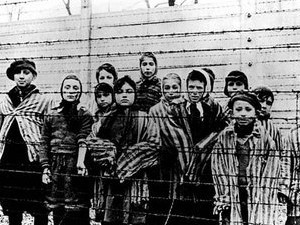
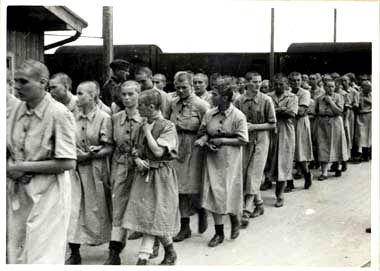



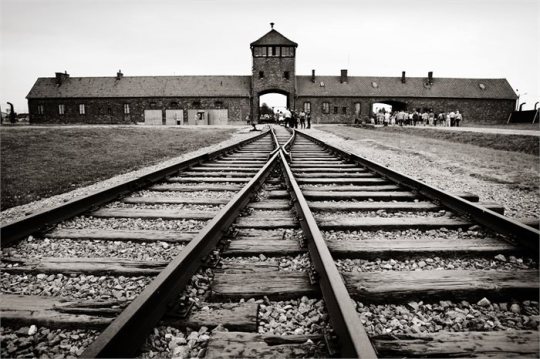
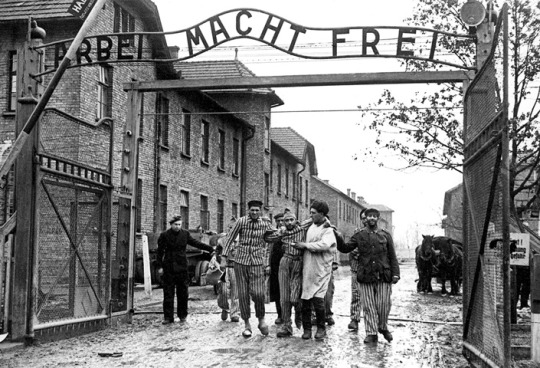
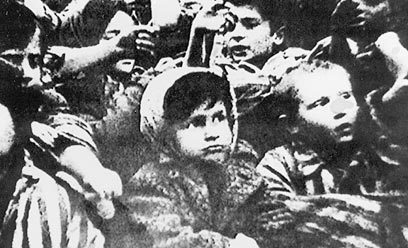


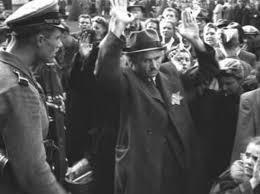


יום הזכרון לשואה ולגבורה תשפ"ג
Yom HaShoah (Holocaust Memorial Day) 2023
#yom hashoah#holocaust memorial day#holocaust remembrance day#holocaust#יום השואה#יום הזכרון לשואה ולגבורה
45 notes
·
View notes
Text

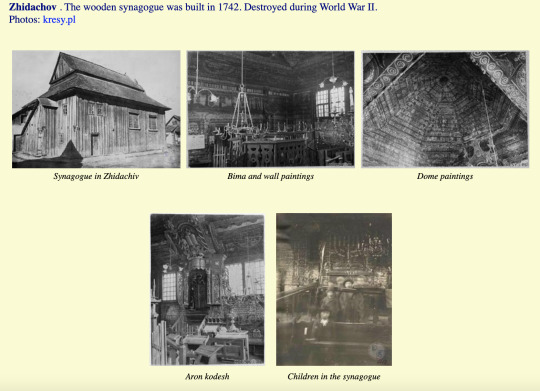






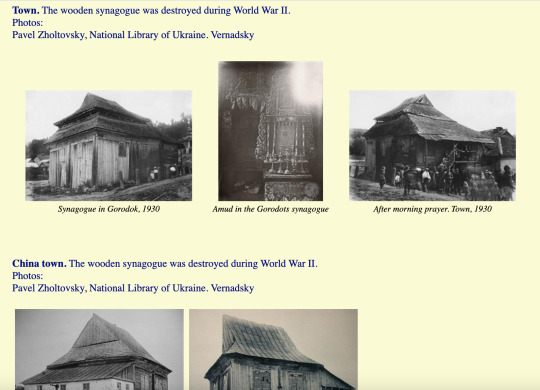
Something I have been thinking about a lot is not just the immense destruction of human life in the Holocaust but also the immense loss of material culture. I've been obsessed with this website that documents Jewish life in Ukraine. I think when we remember the 6 million Jews and Sinti and Roma people and gays and disabled people etc. murdered by Nazis and their allies, we must have some awareness of the material loss as well. There was nothing to go back to. When I see people vilifying Jews who fled to Palestine as refugees (and I never want to see that but unfortunately I do) I feel like screaming. They burned down villages. Synagogues that remained were turned into factories, or dismantled, the bricks reused to pave roads. I understand how impossible it would have been to return to Europe after the war, but a big part of me wishes that more Jews had returned and rebuilt.
6 notes
·
View notes


